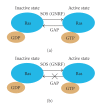Clinical relevance of KRAS in human cancers
- PMID: 20617134
- PMCID: PMC2896632
- DOI: 10.1155/2010/150960
Clinical relevance of KRAS in human cancers
Abstract
The KRAS gene (Ki-ras2 Kirsten rat sarcoma viral oncogene homolog) is an oncogene that encodes a small GTPase transductor protein called KRAS. KRAS is involved in the regulation of cell division as a result of its ability to relay external signals to the cell nucleus. Activating mutations in the KRAS gene impair the ability of the KRAS protein to switch between active and inactive states, leading to cell transformation and increased resistance to chemotherapy and biological therapies targeting epidermal growth factor receptors. This review highlights some of the features of the KRAS gene and the KRAS protein and summarizes current knowledge of the mechanism of KRAS gene regulation. It also underlines the importance of activating mutations in the KRAS gene in relation to carcinogenesis and their importance as diagnostic biomarkers, providing clues regarding human cancer patients' prognosis and indicating potential therapeutic approaches.
Figures




Similar articles
-
Concomitant occurrence of EGFR (epidermal growth factor receptor) and KRAS (V-Ki-ras2 Kirsten rat sarcoma viral oncogene homolog) mutations in an ALK (anaplastic lymphoma kinase)-positive lung adenocarcinoma patient with acquired resistance to crizotinib: a case report.BMC Res Notes. 2013 Nov 26;6:489. doi: 10.1186/1756-0500-6-489. BMC Res Notes. 2013. PMID: 24279718 Free PMC article.
-
Cycleave polymerase chain reaction method is practically applicable for V-Ki-ras2 Kirsten rat sarcoma viral oncogene homolog (KRAS)/V-raf murine sarcoma viral oncogene homolog B1 (BRAF) genotyping in colorectal cancer.Transl Res. 2010 Aug;156(2):98-105. doi: 10.1016/j.trsl.2010.05.007. Epub 2010 Jun 19. Transl Res. 2010. PMID: 20627194
-
KRAS mutations in lung cancer.Clin Lung Cancer. 2013 May;14(3):205-14. doi: 10.1016/j.cllc.2012.09.007. Epub 2012 Nov 1. Clin Lung Cancer. 2013. PMID: 23122493 Review.
-
Multifunctional imaging signature for V-KI-RAS2 Kirsten rat sarcoma viral oncogene homolog (KRAS) mutations in colorectal cancer.J Nucl Med. 2014 Mar;55(3):386-91. doi: 10.2967/jnumed.113.120485. Epub 2014 Feb 10. J Nucl Med. 2014. PMID: 24516257
-
Kirsten Ras* oncogene: significance of its discovery in human cancer research.Oncotarget. 2016 Jul 19;7(29):46717-46733. doi: 10.18632/oncotarget.8773. Oncotarget. 2016. PMID: 27102293 Free PMC article. Review.
Cited by
-
Study of KRAS-Related miRNA Expression in Colorectal Cancer.Cancer Manag Res. 2022 Oct 17;14:2987-3008. doi: 10.2147/CMAR.S368551. eCollection 2022. Cancer Manag Res. 2022. PMID: 36262749 Free PMC article.
-
KRAS Mutation Subtypes and Their Association with Other Driver Mutations in Oncogenic Pathways.Cells. 2024 Jul 19;13(14):1221. doi: 10.3390/cells13141221. Cells. 2024. PMID: 39056802 Free PMC article. Review.
-
Point Mutation Specific Antibodies in B-Cell and T-Cell Lymphomas and Leukemias: Targeting IDH2, KRAS, BRAF and Other Biomarkers RHOA, IRF8, MYD88, ID3, NRAS, SF3B1 and EZH2.Diagnostics (Basel). 2021 Mar 27;11(4):600. doi: 10.3390/diagnostics11040600. Diagnostics (Basel). 2021. PMID: 33801781 Free PMC article. Review.
-
A comparison of Direct sequencing, Pyrosequencing, High resolution melting analysis, TheraScreen DxS, and the K-ras StripAssay for detecting KRAS mutations in non small cell lung carcinomas.J Exp Clin Cancer Res. 2012 Sep 20;31(1):79. doi: 10.1186/1756-9966-31-79. J Exp Clin Cancer Res. 2012. PMID: 22995035 Free PMC article.
-
Testicular germ cell tumor genomics.Curr Opin Urol. 2017 Jan;27(1):41-47. doi: 10.1097/MOU.0000000000000347. Curr Opin Urol. 2017. PMID: 27584029 Free PMC article. Review.
References
-
- Der CJ, Cooper GM. Altered gene products are associated with activation of cellular rask genes in human lung and colon carcinomas. Cell. 1983;32(1):201–208. - PubMed
-
- Esser D, Bauer B, Wolthuis RMF, Wittinghofer A, Cool RH, Bayer P. Structure determination of the ras-binding domain of the Ral-specific guanine nucleotide exchange factor Rlf. Biochemistry. 1998;37(39):13453–13462. - PubMed
-
- Zuber J, Tchernitsa OI, Hinzmann B, et al. A genome-wide survey of RAS transformation targets. Nature Genetics. 2000;24(2):144–152. - PubMed
Publication types
MeSH terms
Substances
LinkOut - more resources
Full Text Sources
Other Literature Sources
Miscellaneous

